I have been going on a fair bit about what I think an ideal road unicycle set up should be to anybody who cared to listen to my raving and ranting. In my opinion, a road unicycle should be set up with a similar riding position to a bicycle. I have been experimenting recently, and so far, I’m pretty happy with that theory.
Why?
Bicyclists have been riding long tours/races for many years, but until the advent of 36″ wheels, long distance road unicycling was so tedius that not many people did it for fun! Unicycles were designed to do tricks with, not for riding for extended periods. You can sit on a bike and pedal away for hours, yet even the most comfortable unicycle seats cause crotch discomfort relatively quickly. Bicyclists know what they’re doing in terms of setting up a comfortable machine.
What’s the difference between a bicycle and unicycle? A bike distributes weight evenly between the handlebar and the seat, and the seat does not curve upwards to wedge against your crotch. The handlebar keeps you from sliding off the front of the bike seat. Unicycles are far too upright. All the weight is on your crotch.
A lower position also gives greater stability by lowering your centre of gravity.
There have been various attempts at handlebars on unicycles, but I have yet to see a production bar that let’s you stretch your arms out like on a bike. The closest thing is probably the T7 handlebar, but it is far too upright and much too short.
If you look at photos of people riding the T7 (there are nice ones of Chuck Edwall pg 17 and also of Jan Longeman pg 31 in the current Issue 7 Unicycle Magazine Dec08/Jan09), you’ll see that the T7 is up against their chest. It is like riding the Graeme Obree style Hour Record position. Very aerodynamic, but with your elbow flexed at more than 90 degrees not that great for control or comfort.
Having a more bike-like position is NOT about getting a stretched out Time-trial like position either. What I’m advocating is a position that has your back fairly straight, about 45 degrees, elbows slightly bent with arms relaxed. If you imagine superimposing someone riding a bike on a unicycle; that is the position I’m talking about.
Many of us already ride in a similar posture to a bicyclist. The only difference is that we end up holding a short stubby handle from the seat, instead of more comfortably out front. Think about it less as a ‘body positioning’ exercise as it is about hand/arm positioning. Take a look at this photo of me….my arms are cramped, elbows flexed at 90 degrees, with no leverage and looking very uncomfortable:
Others have tried to reposition their hands/arms by extension handlebars attached to the front of the unicycle. We have seen various extension set-ups, from custom ones to production versions like the T7. None of them are satisfactory, because of the need to have long things sticking out from the frame with no support. They are often overbuilt in order to maintain strength, at the expense of weight and a higher centre of gravity.
The solution would be to create a V-frame. Instead of having one fork leg, there are two, coming out as a V from the bearing holders. The front fork allows a stem to be clamped onto, whilst the back fork leg would hold the seatpost. We have already seen a couple of examples of this, in Pete Perons Purple Phaze unicycle. However, until we get a production V-frame, we’re stuck with trying to use long handles.
The other alternative is to use two short poles (front and back), instead of one super long handle coming out the front. So the front pole would hold your handlebar setup, and the back one would be used to attach the seat. The seatpost clamps on somewhere in between the two. Two short poles are going to be stronger and stiffer than one long one!
T7 Handlebar Modification
With this in mind, I set about modifying my T-7. Conveniently, it has a T-bar at the back. I had never been able to figure out what it was for, until I realised that it was designed to allow you to mount the seat further back!
This allows a more stretched out position without actually overextending the handlebar, which would weaken the design.
I have used a bike seat, with a BMX clamp. But I’m sure with some creative bolting, it would be possible to put a regular unicycle seat in there. The bar was also wrapped in regular road bike grip tape (not shown).
The test:
It was interesting to mount as the seat is positioned much further back from the handle. It didnt’ take too long to get used to it however and I was off.
The first thing I noticed was how comfortable it was. My weight was evenly distributed between my hands and the seat. With this set-up, I felt like I could ride it all day without any discomfort. It’s still not quite long enough or low enough to be a bike position, but was pretty close. Kind of like riding a bike with a short top-tube and an upright handlebar (A plea to Mr Nimbus: please get rid of that rise in the T7…it’s horrible!).
The extended T7 was vast improvement on just about any other bar I’ve ridden on a unicycle. It felt very natural and bike-like to the point where I was craving for a set of drop bars and hoods!
The main problem I encountered was nothing to do with the T7 at all. It was caused by the wide KH36″ frame consistently whacking against my knees when using this position. The square corners are particularly painful! It took a fair amount of adjustment of the seat (mainly pushing it back on the rails and angling the whole thing upwards) to try and minimise this, but I still ended up riding with a somewhat bow legged stance.
Other issues were to do with slowing down, but I didn’t get a chance to test it on any hills. I suspect that the braking power would be limited, not by having a stretched out handlebar, but by how upright the T7 is. There is not much leverage to pull up as your elbows are already flexed. Again, if the T7 was lower (hence elbows less bent), that would improve the pulling power. It may be that you would need also to run brakes and ride this more like a bike anyway (ie use your brakes to slow down rather than leg backpressure).
Turning was interesting because of the bike seat. There is much less material to push against with your thighs. It was more dependent on leaning your body and handlebar. Again, not too dissimilar to riding a bike.
In summary, I think the more stretched out bike like position works great on a road unicycle. The T7 can be modified to get closer to that position, but it’s still too upright and too cramped to be directly comparable.
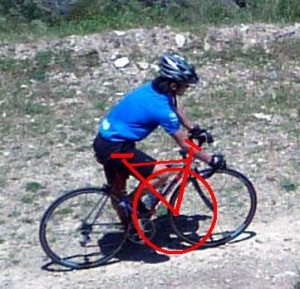
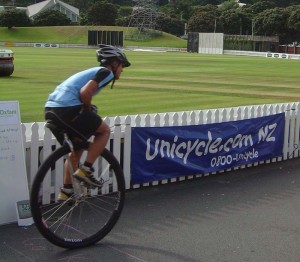
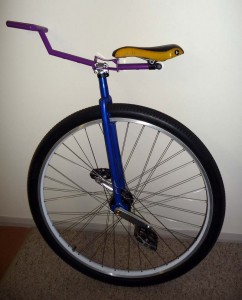
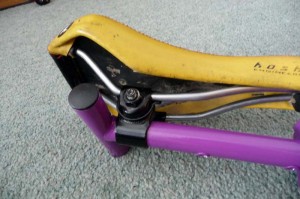

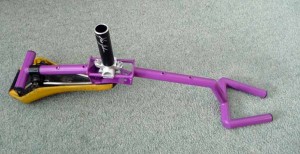
Levi (lpounds)
January 7th, 2009
KEN! I thought of this exact thing recently but gave up on mounting my seat to the ‘T’ part of the T7. Looks like you’ve done it! I was wondering, though, doesn’t the T7 noticeably flex when you hit bumps?
admin
January 7th, 2009
Hi Levi,
The T7 doesn’t flex any more than it did beforehand! It’s a pretty heavy piece of metal. I don’t think the stress on the welds are any different to mounting a unicycle seat on the normal seatplate. The only difference is that the back welds are now also taking some stress along with the front.
It would be stronger than having a super long bar coming off the front that is unsupported.
Steve Relles
January 8th, 2009
Ken – thanks for this experiment. Since I have my 2008 “Big One” frame, I wonder if it would be less of a knee-banger.
admin
January 8th, 2009
Hi Steve,
Yes, I think so. And also, with it being a round rather than a square crown, it should be less painful if it does rub on your legs.
michael menghe
January 26th, 2009
Neat idea!
I do however have a concern about all “V” type frames and any other extension mod. Although I do agree that simply increasing the length of your handle bar accomplishes little and weighs a little too much, when you move the seat behind the center of the wheel, it creates a bottom bracket offset, which I feel to be inferior in terms of efficiency. Just a hunch, I can’t prove it and have been looking for information on this topic. I recently inquired a few high profile bicycle companies about what they thought about the offset, and hope to hear from them soon. What is your opinion on my concern? Like I said, I’m not too confident that there even is a downfall to this design, I’m just a little skeptical and would like to be rested assured that my cash dollars will not have been spent in vain.
thanks,
Michael Menghe
Ps: what do you think about riding a typical bike seat? is it any less stable?
admin
January 28th, 2009
Thanks Michael,
I’m not sure what you mean by ‘bottom bracket offset’. You are still balanced over the axle (you have to be!), the only difference is that your torso is lower down. In fact, for me the position changes little. I ride exactly like this anyway. The only difference with a short handle is that my arms are bent in an uncomfortable position and there is little support for my back!
As for spending money on this sort of design…you can wait for others to experiment, or you could be one of the pioneers of unicycle design. Like the guys who stuck fat tyres on their clunker bikes 30yrs ago…that evolved into todays mountainbikes.
The bike seat is perfectly stable as long as you ride it like a bike. Unicycle seats were designed for freestyle unicyclists. They rely on a curved seat wedging agains’t their crotch to steer with. There is no need for that on a road unicycle with a handlebar.
Nathan Hoover
January 28th, 2009
Looks great Ken. I would love to try riding a setup like that. It’s funny how you’re using two rail adapters!
I am a little concerned about the T7 welds breaking as many people have had problems. The heavier you are, the more stress on that back one where the seat is mounted. You’re so light that maybe it will never be a problem, but I wonder how it would do with a heavier rider. I am very interested to see how this works out and how you like it after more testing over all kinds of terrain.
admin
January 28th, 2009
Nathan, I’m using the T7 to try out a the concept. It was never designed for this sort of thing, and is still too short.
When I get around to it, I’ll design a proper T-frame or V-frame setup.
Scott Wilton
January 28th, 2009
I agree with the fact that it isn’t long enough still, even though I have only rode it around the block (due to weather and flat tire, no spare 29er tubes). It will be interesting to see how climbing goes.